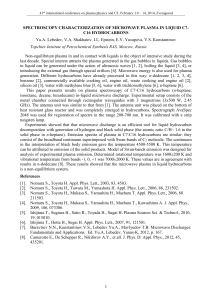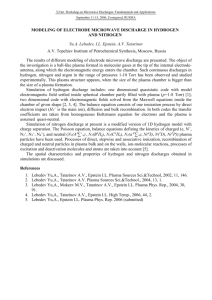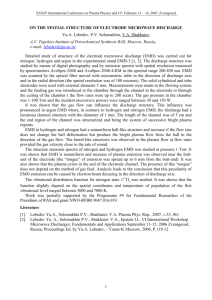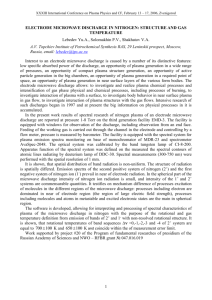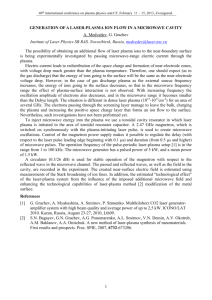JM-Lebedev_e
advertisement
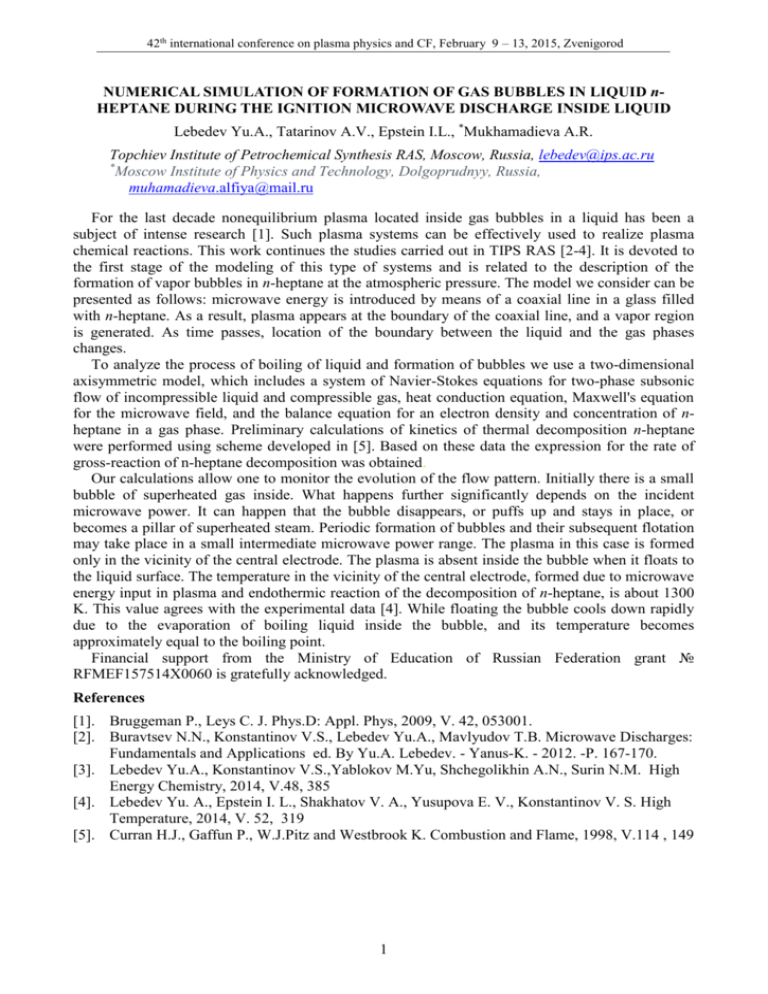
42th international conference on plasma physics and CF, February 9 – 13, 2015, Zvenigorod NUMERICAL SIMULATION OF FORMATION OF GAS BUBBLES IN LIQUID nHEPTANE DURING THE IGNITION MICROWAVE DISCHARGE INSIDE LIQUID Lebedev Yu.A., Tatarinov A.V., Epstein I.L., *Mukhamadieva A.R. Topchiev Institute of Petrochemical Synthesis RAS, Moscow, Russia, lebedev@ips.ac.ru * Moscow Institute of Physics and Technology, Dolgoprudnyy, Russia, muhamadieva.alfiya@mail.ru For the last decade nonequilibrium plasma located inside gas bubbles in a liquid has been a subject of intense research [1]. Such plasma systems can be effectively used to realize plasma chemical reactions. This work continues the studies carried out in TIPS RAS [2-4]. It is devoted to the first stage of the modeling of this type of systems and is related to the description of the formation of vapor bubbles in n-heptane at the atmospheric pressure. The model we consider can be presented as follows: microwave energy is introduced by means of a coaxial line in a glass filled with n-heptane. As a result, plasma appears at the boundary of the coaxial line, and a vapor region is generated. As time passes, location of the boundary between the liquid and the gas phases changes. To analyze the process of boiling of liquid and formation of bubbles we use a two-dimensional axisymmetric model, which includes a system of Navier-Stokes equations for two-phase subsonic flow of incompressible liquid and compressible gas, heat conduction equation, Maxwell's equation for the microwave field, and the balance equation for an electron density and concentration of nheptane in a gas phase. Preliminary calculations of kinetics of thermal decomposition n-heptane were performed using scheme developed in [5]. Based on these data the expression for the rate of gross-reaction of n-heptane decomposition was obtained. Our calculations allow one to monitor the evolution of the flow pattern. Initially there is a small bubble of superheated gas inside. What happens further significantly depends on the incident microwave power. It can happen that the bubble disappears, or puffs up and stays in place, or becomes a pillar of superheated steam. Periodic formation of bubbles and their subsequent flotation may take place in a small intermediate microwave power range. The plasma in this case is formed only in the vicinity of the central electrode. The plasma is absent inside the bubble when it floats to the liquid surface. The temperature in the vicinity of the central electrode, formed due to microwave energy input in plasma and endothermic reaction of the decomposition of n-heptane, is about 1300 K. This value agrees with the experimental data [4]. While floating the bubble cools down rapidly due to the evaporation of boiling liquid inside the bubble, and its temperature becomes approximately equal to the boiling point. Financial support from the Ministry of Education of Russian Federation grant № RFMEF157514X0060 is gratefully acknowledged. References [1]. Bruggeman P., Leys C. J. Phys.D: Appl. Phys, 2009, V. 42, 053001. [2]. Buravtsev N.N., Konstantinov V.S., Lebedev Yu.A., Mavlyudov T.B. Microwave Discharges: Fundamentals and Applications ed. By Yu.A. Lebedev. - Yanus-K. - 2012. -P. 167-170. [3]. Lebedev Yu.A., Konstantinov V.S.,Yablokov M.Yu, Shchegolikhin A.N., Surin N.M. High Energy Chemistry, 2014, V.48, 385 [4]. Lebedev Yu. A., Epstein I. L., Shakhatov V. A., Yusupova E. V., Konstantinov V. S. High Temperature, 2014, V. 52, 319 [5]. Curran H.J., Gaffun P., W.J.Pitz and Westbrook K. Combustion and Flame, 1998, V.114 , 149 1
